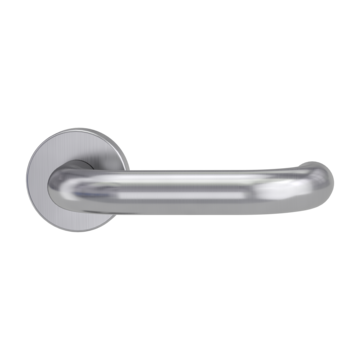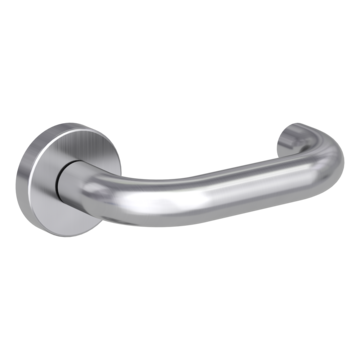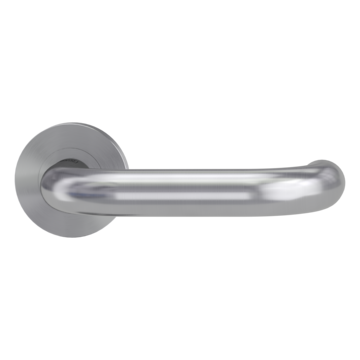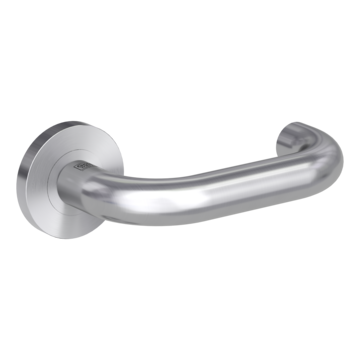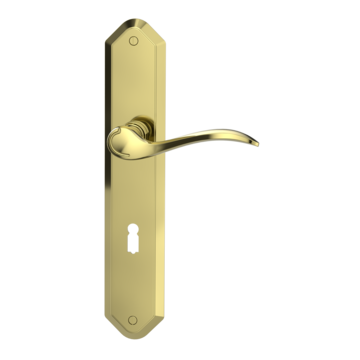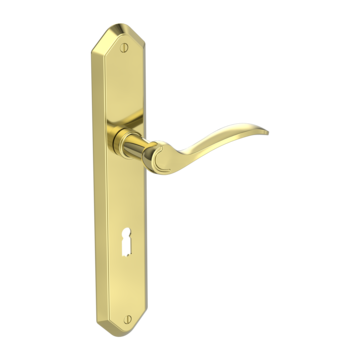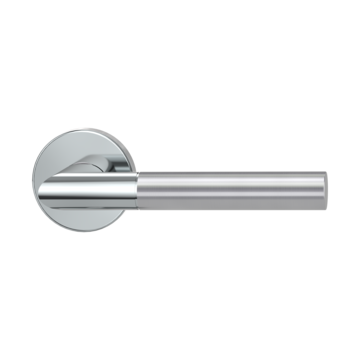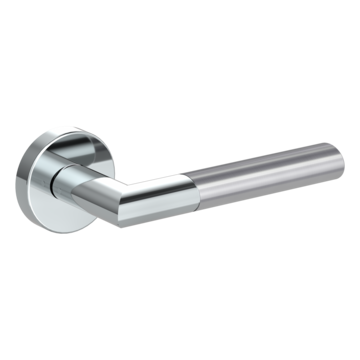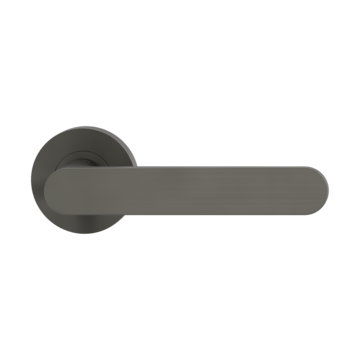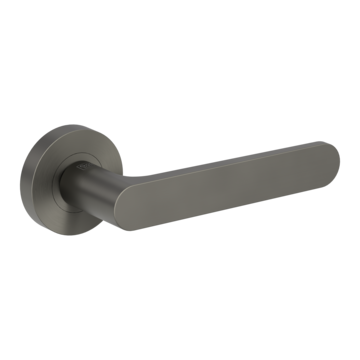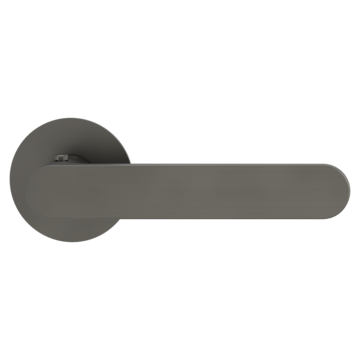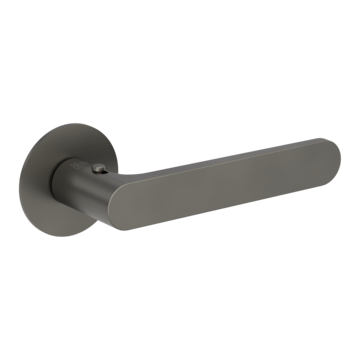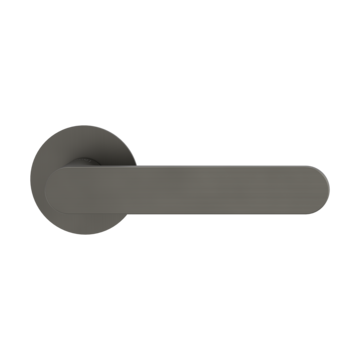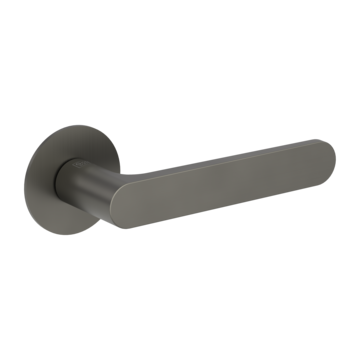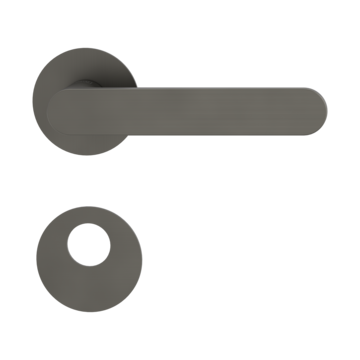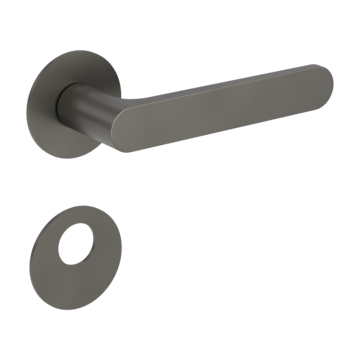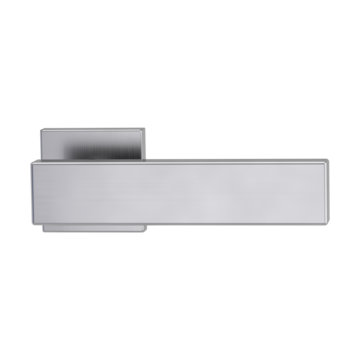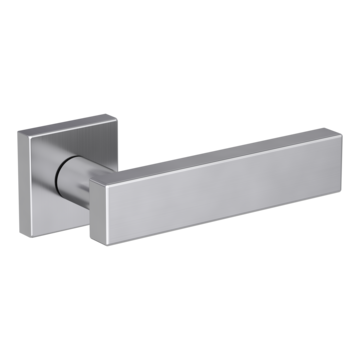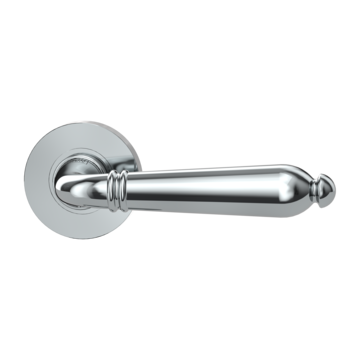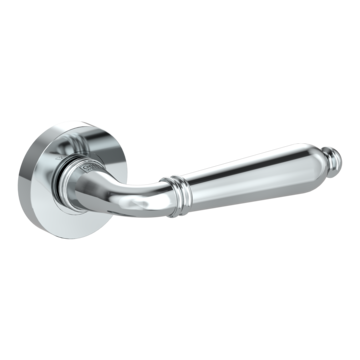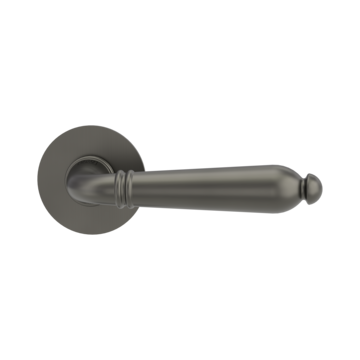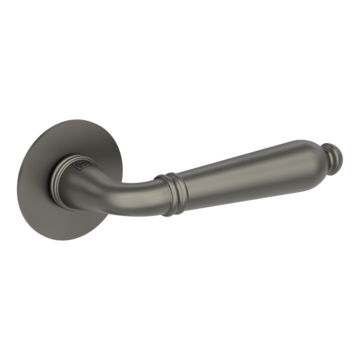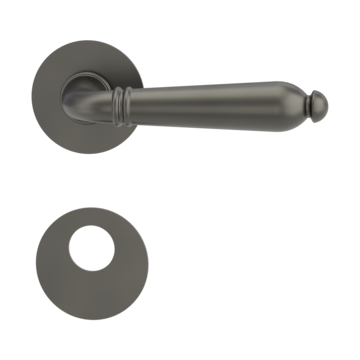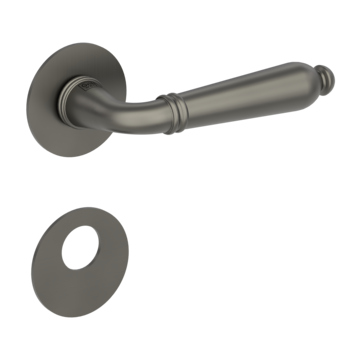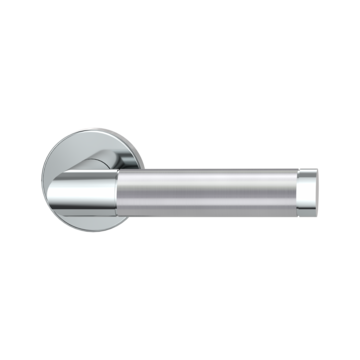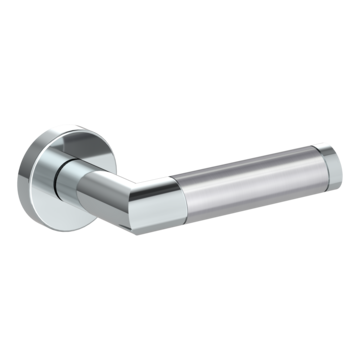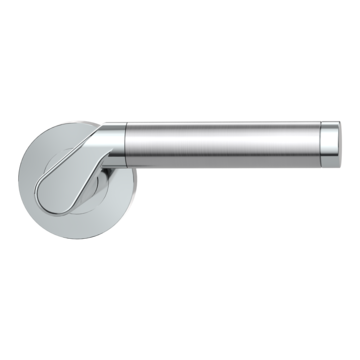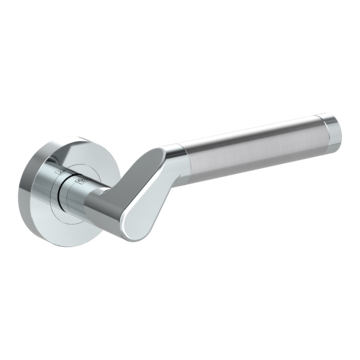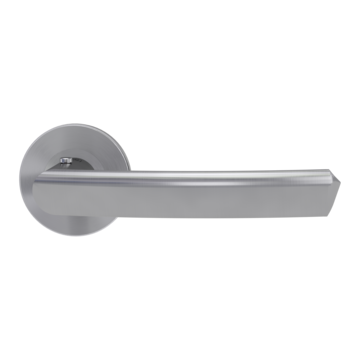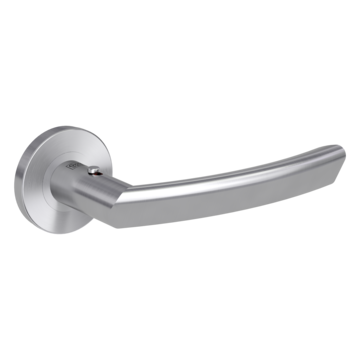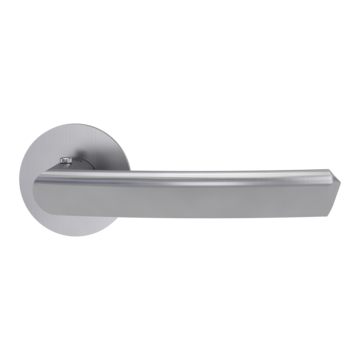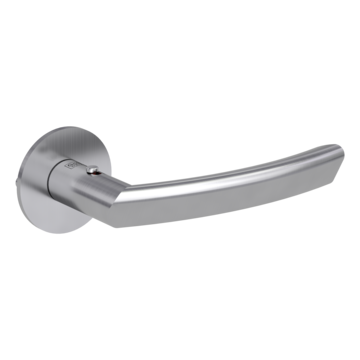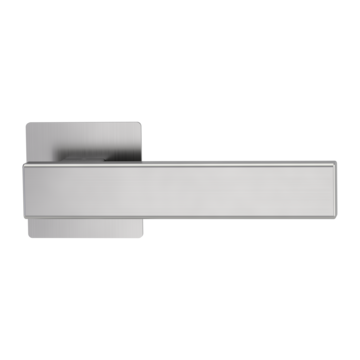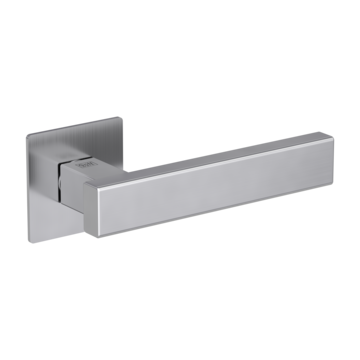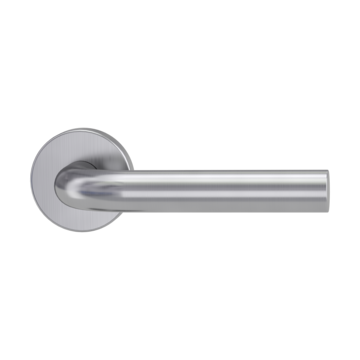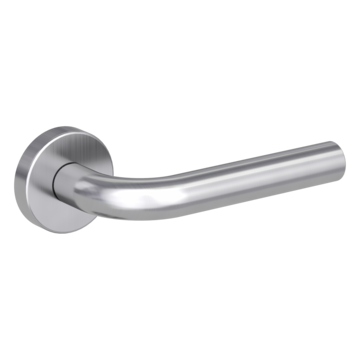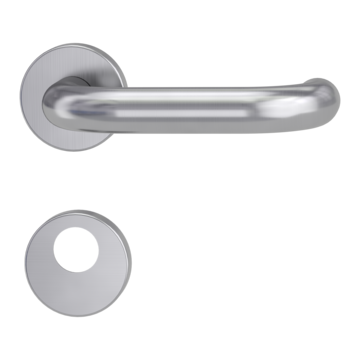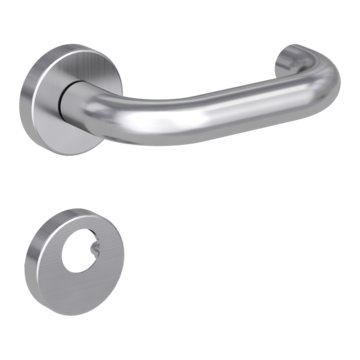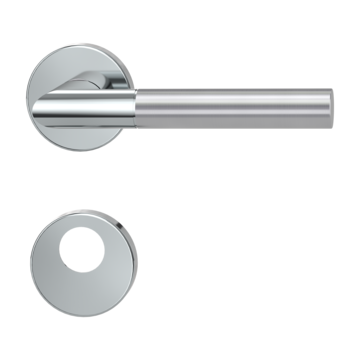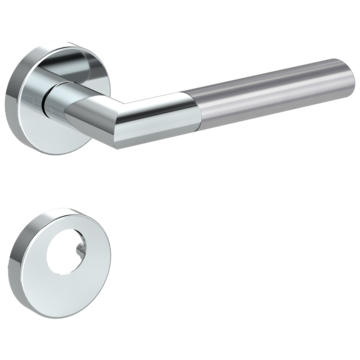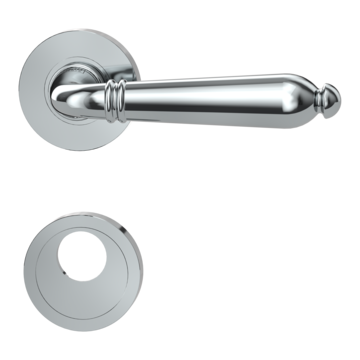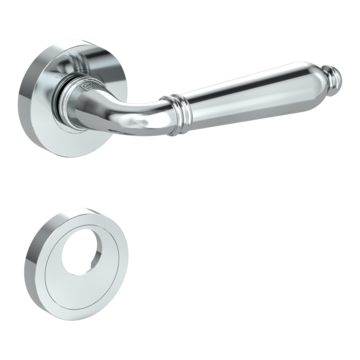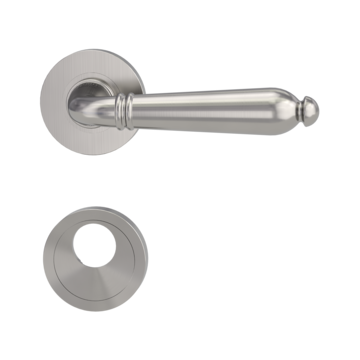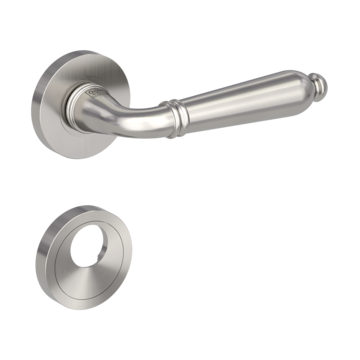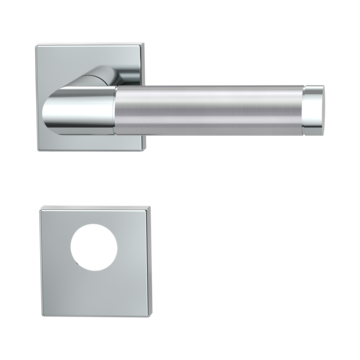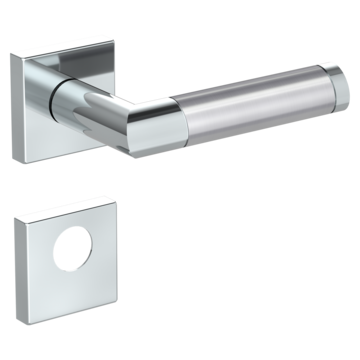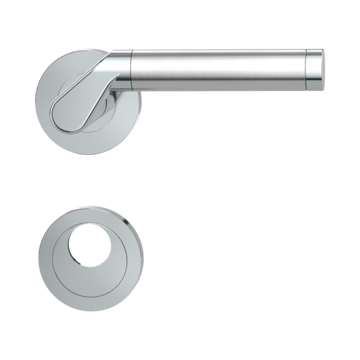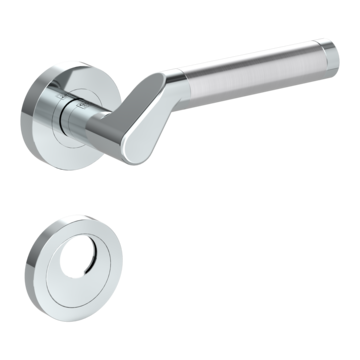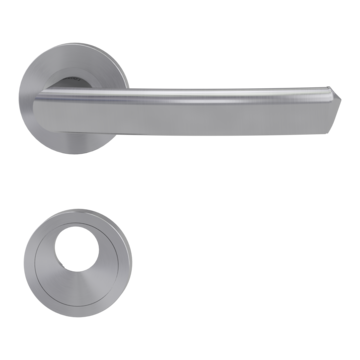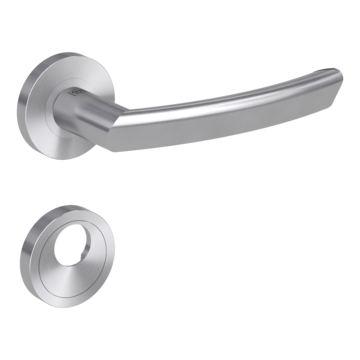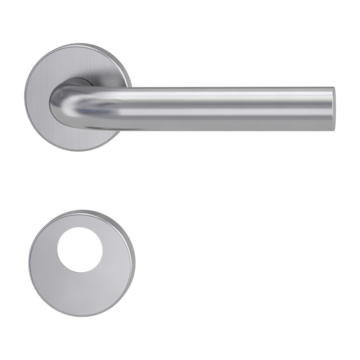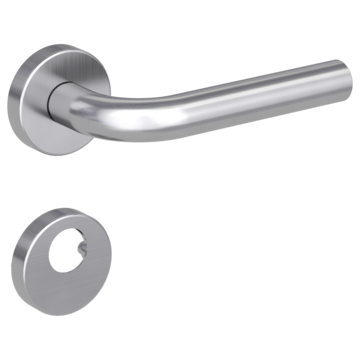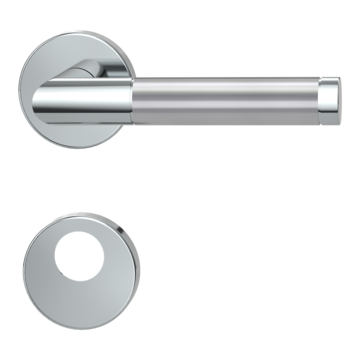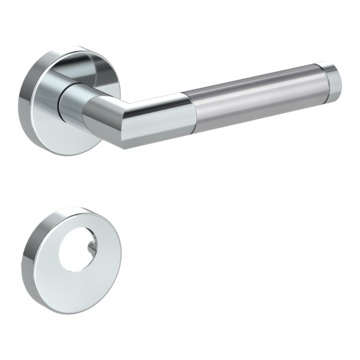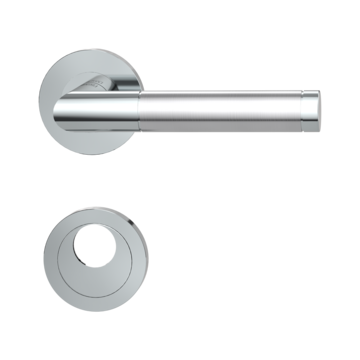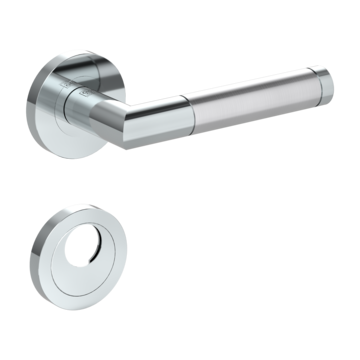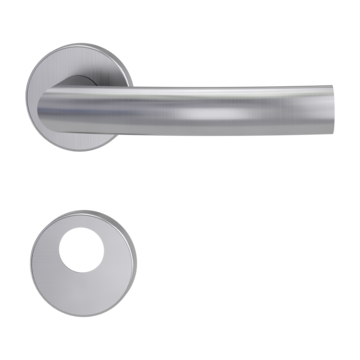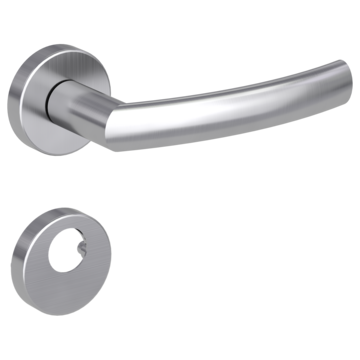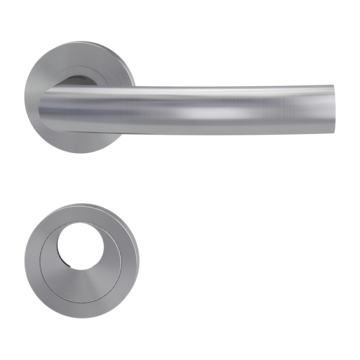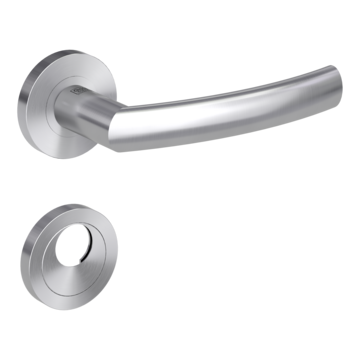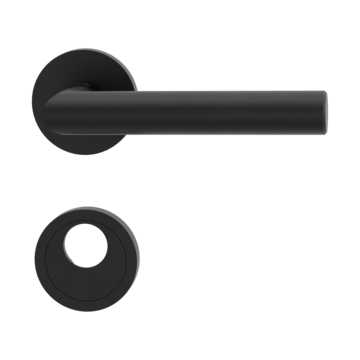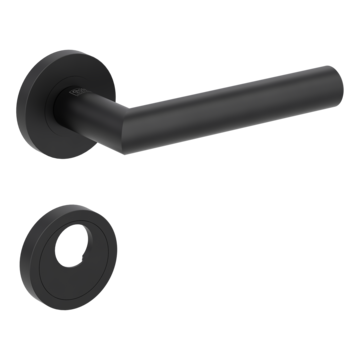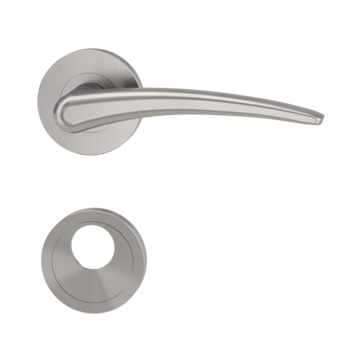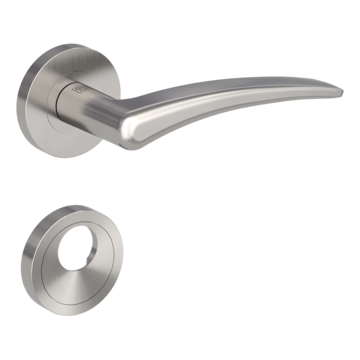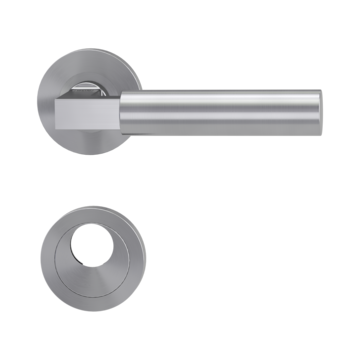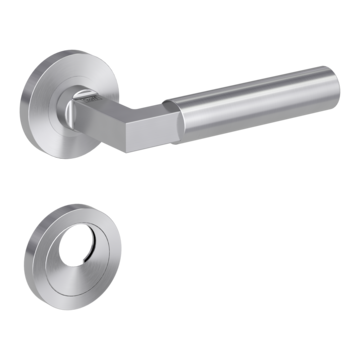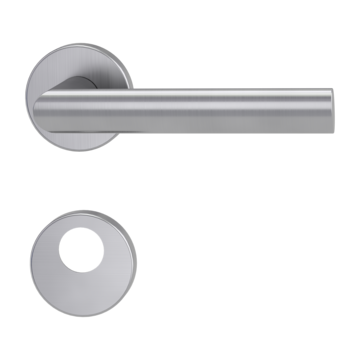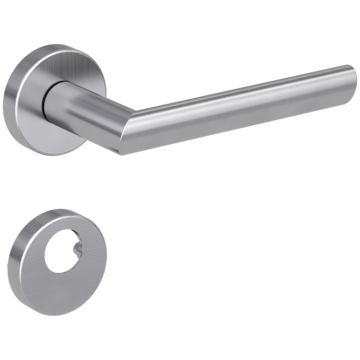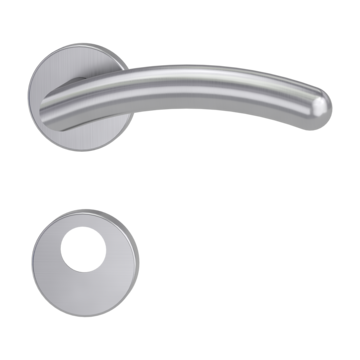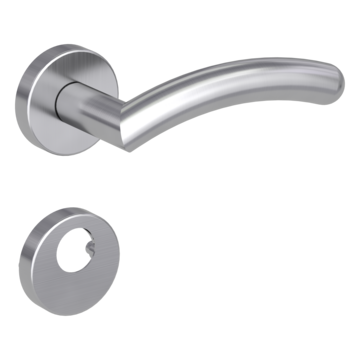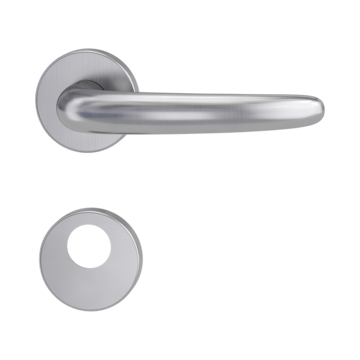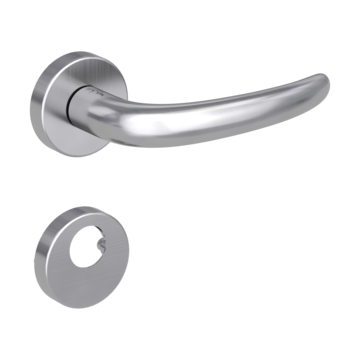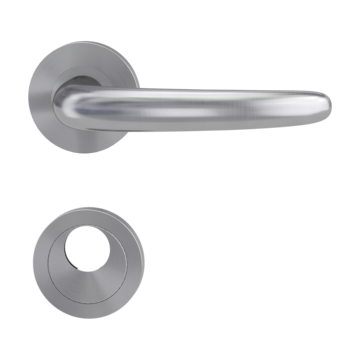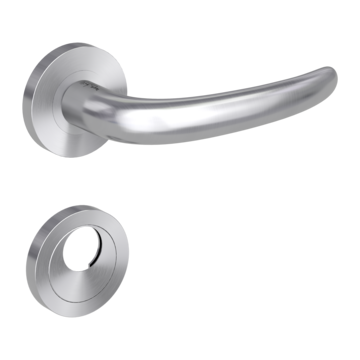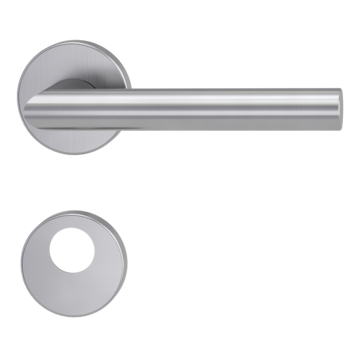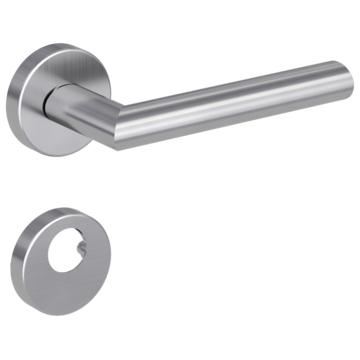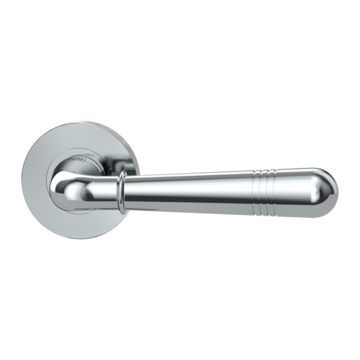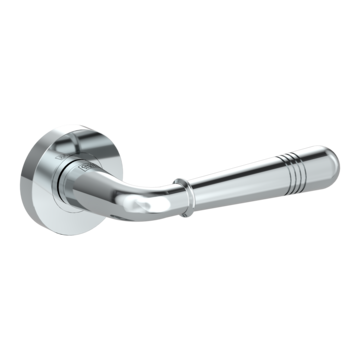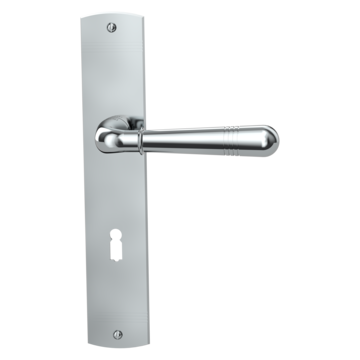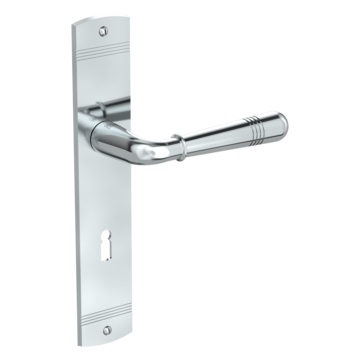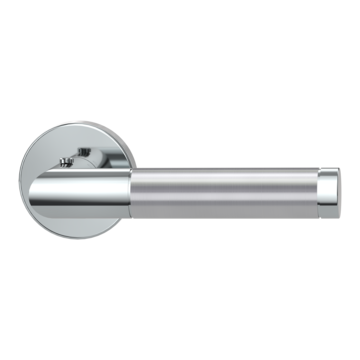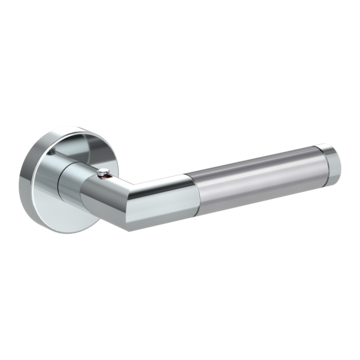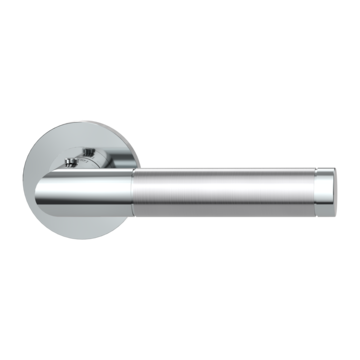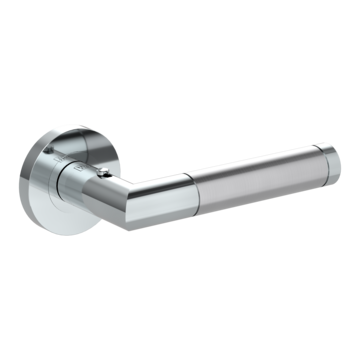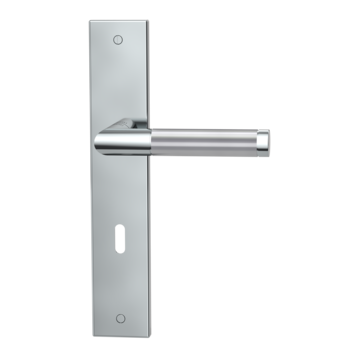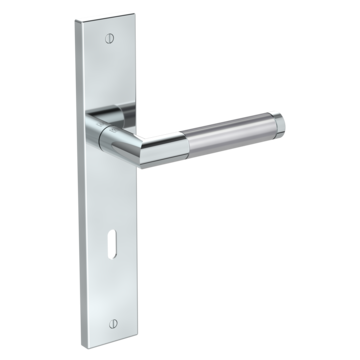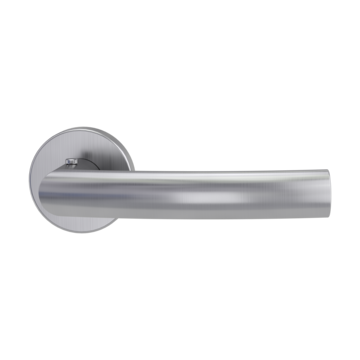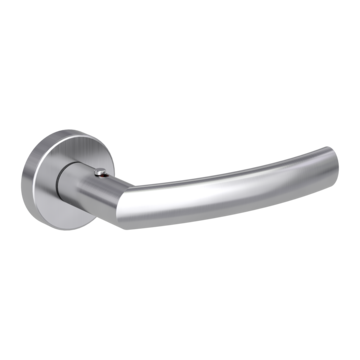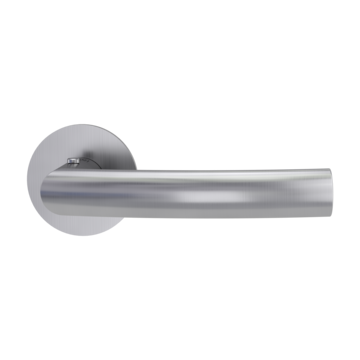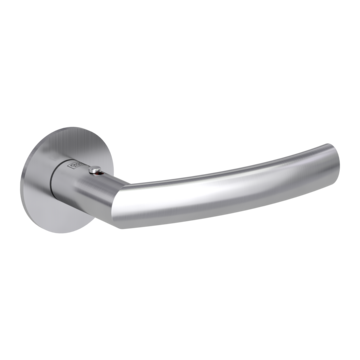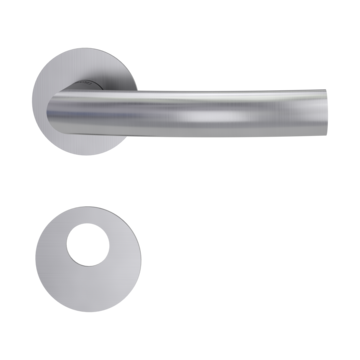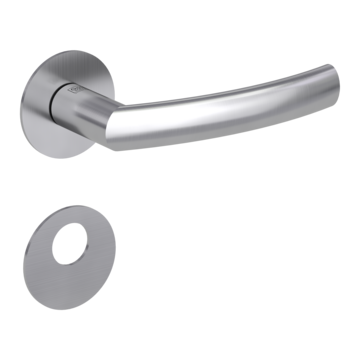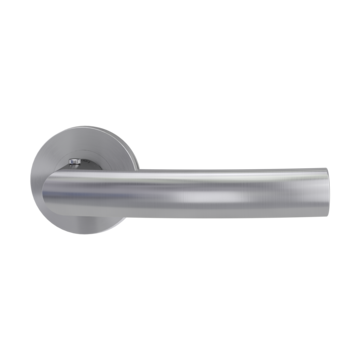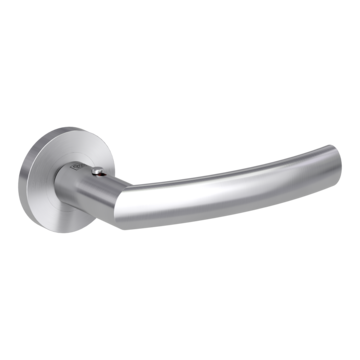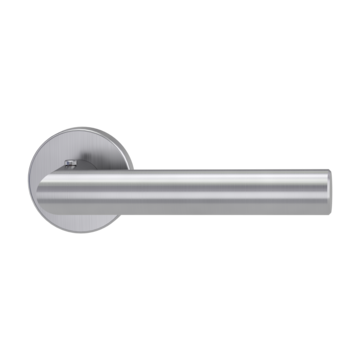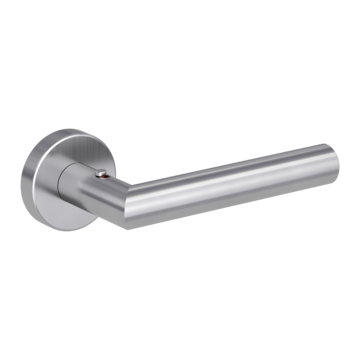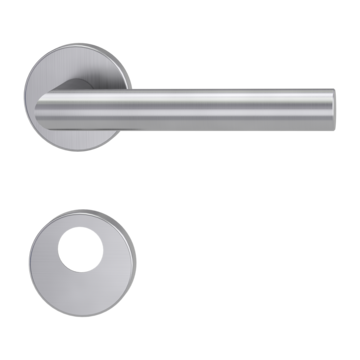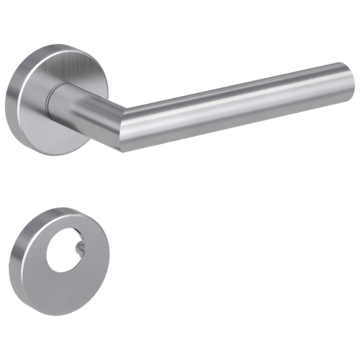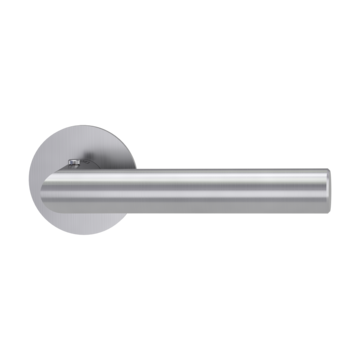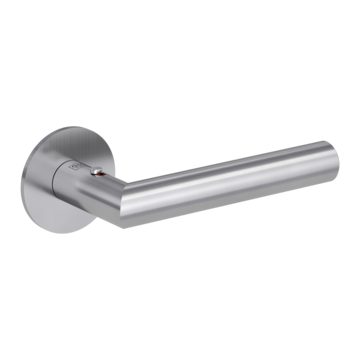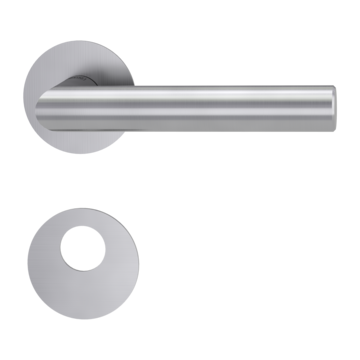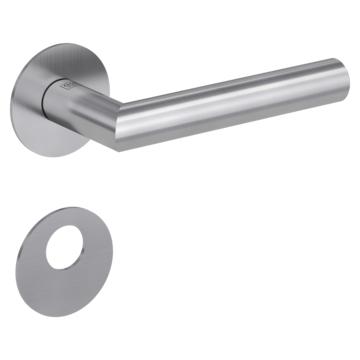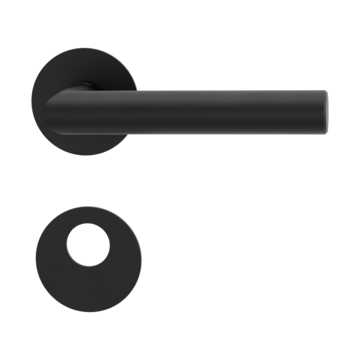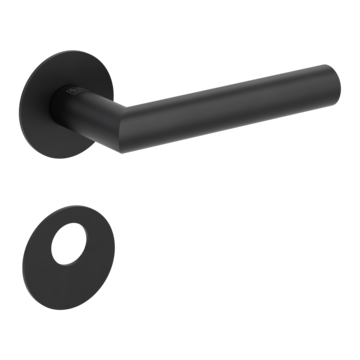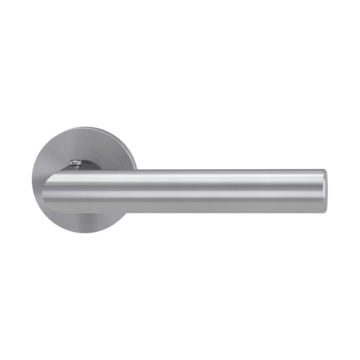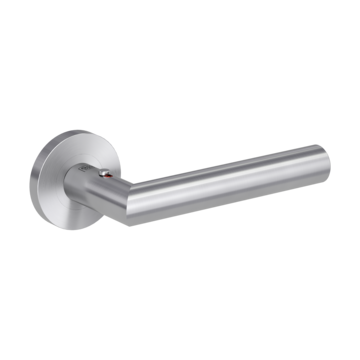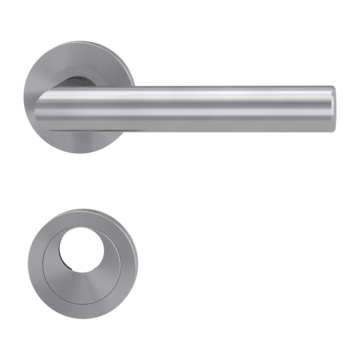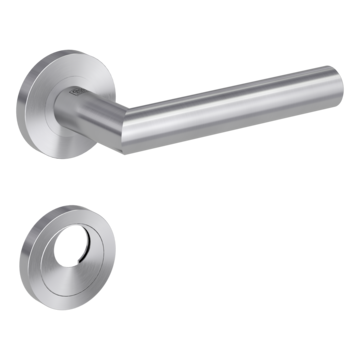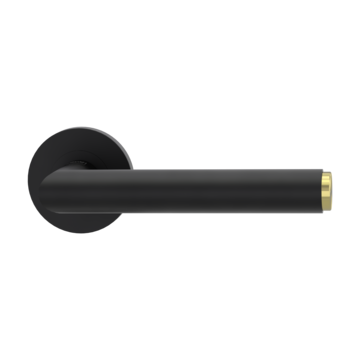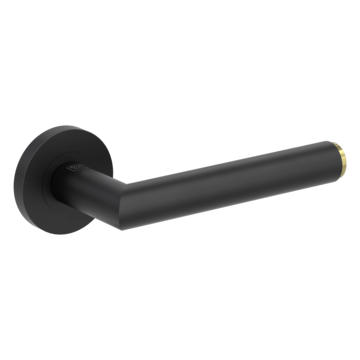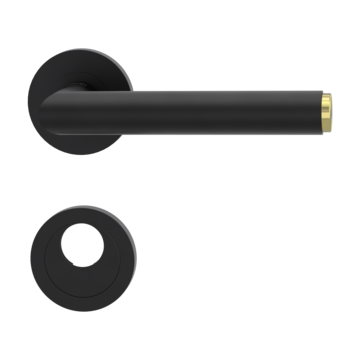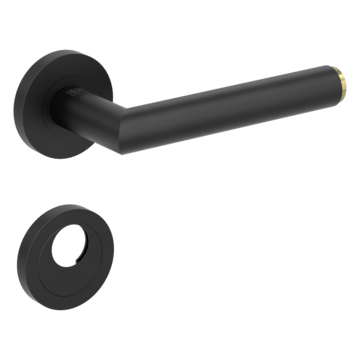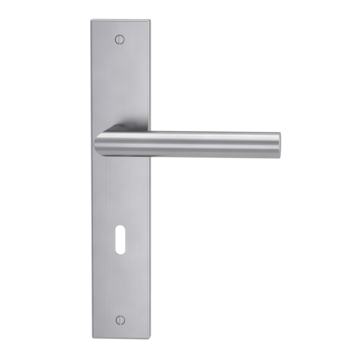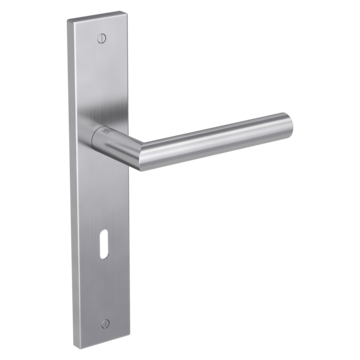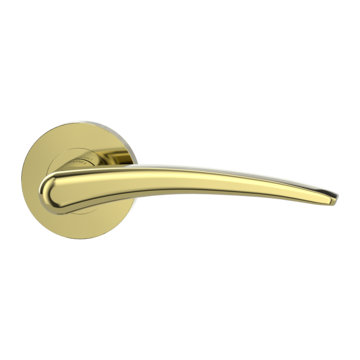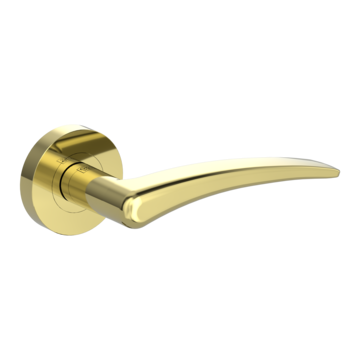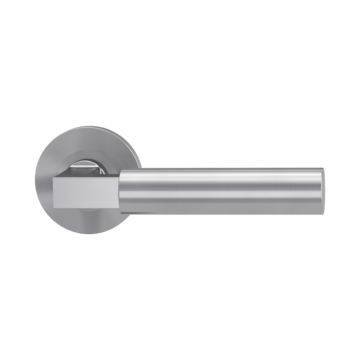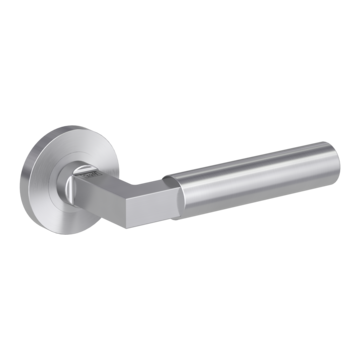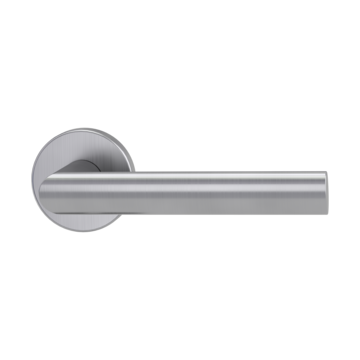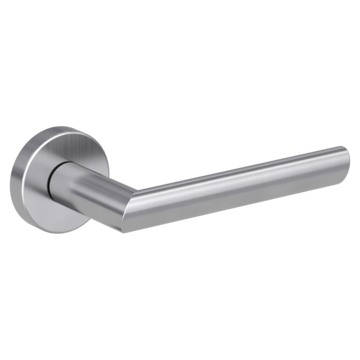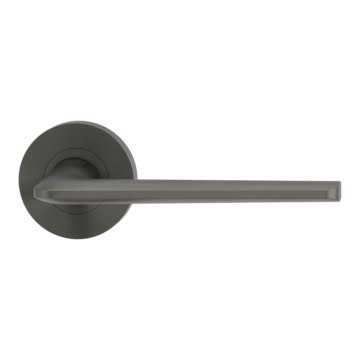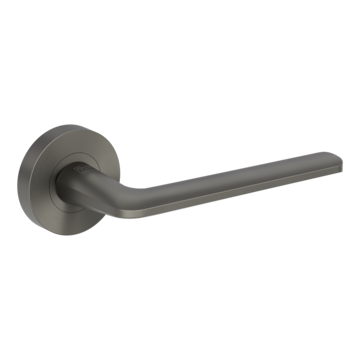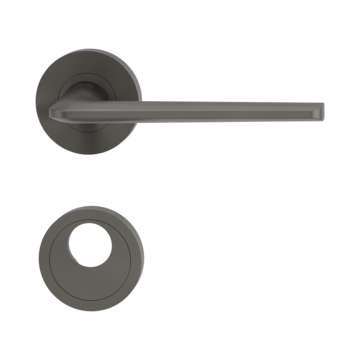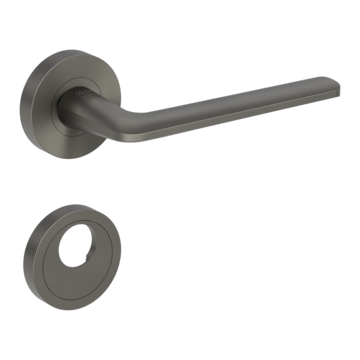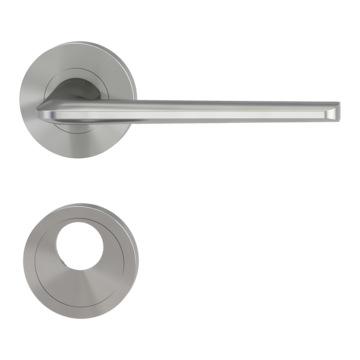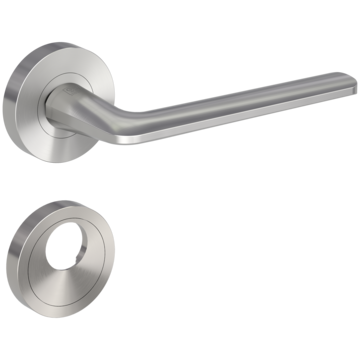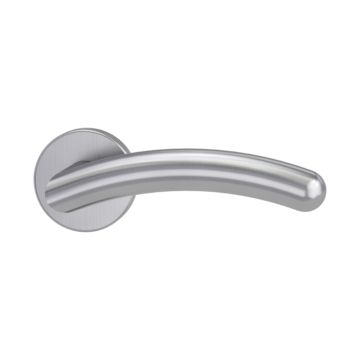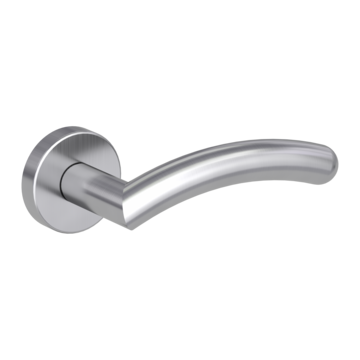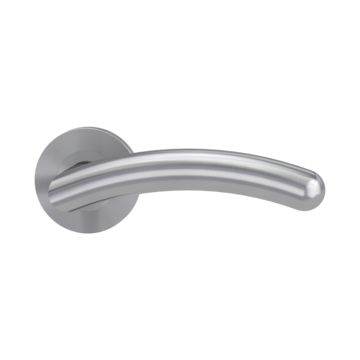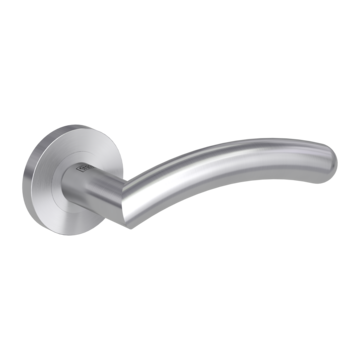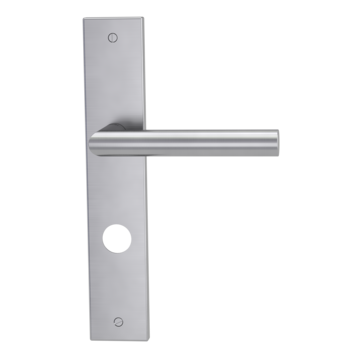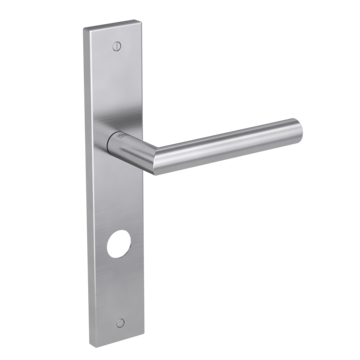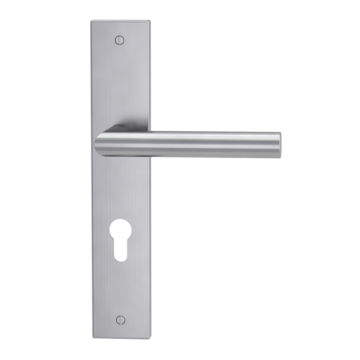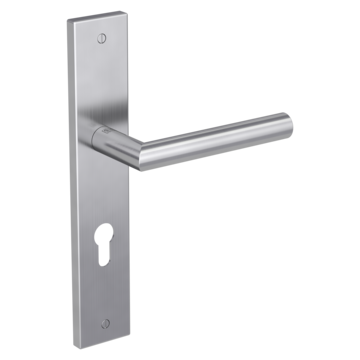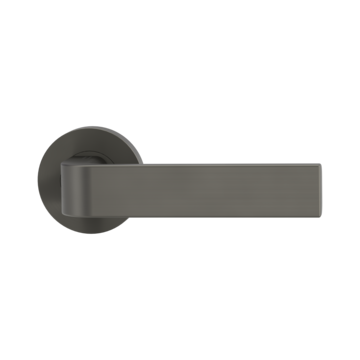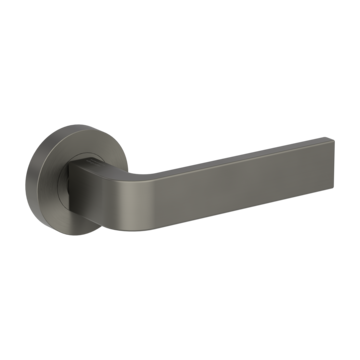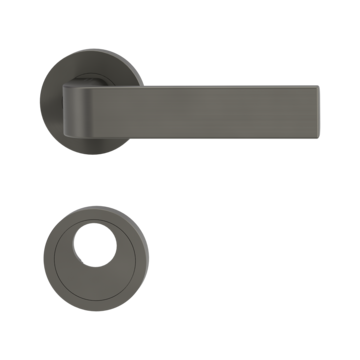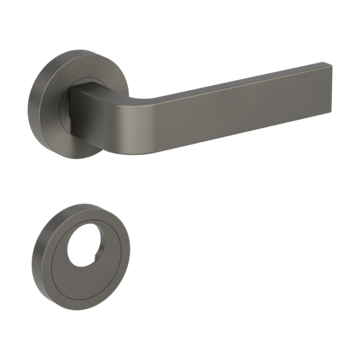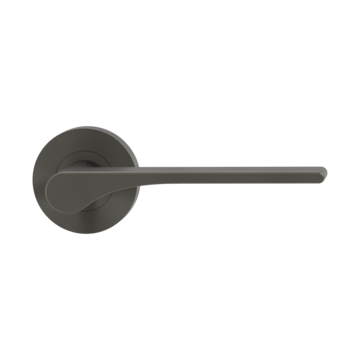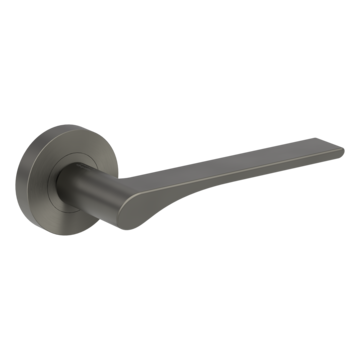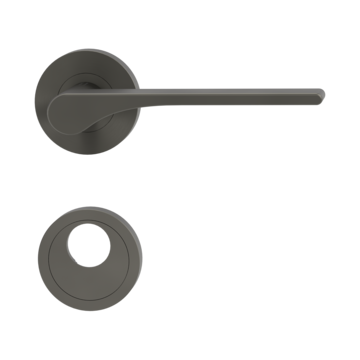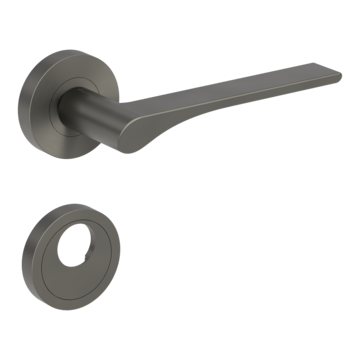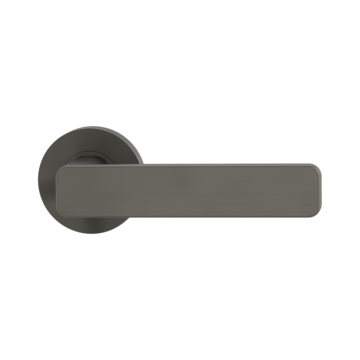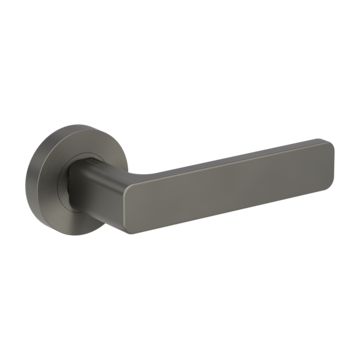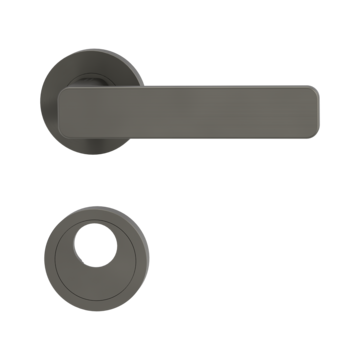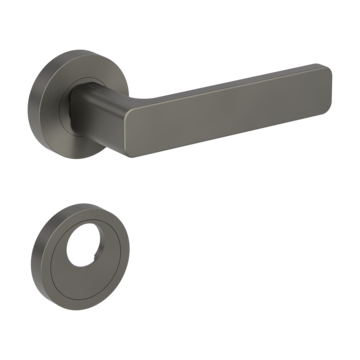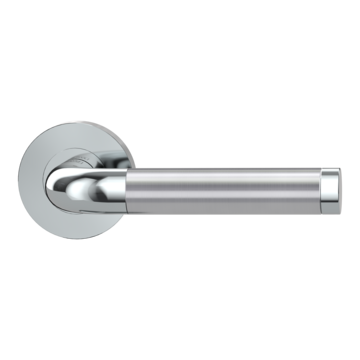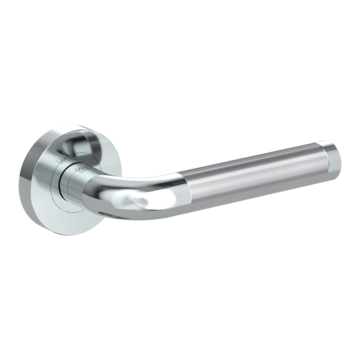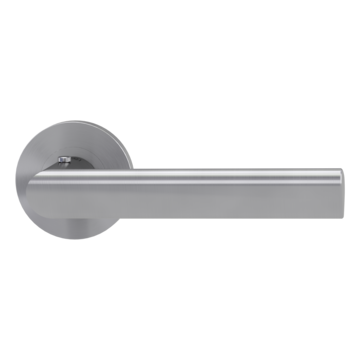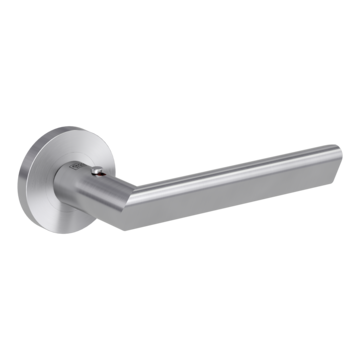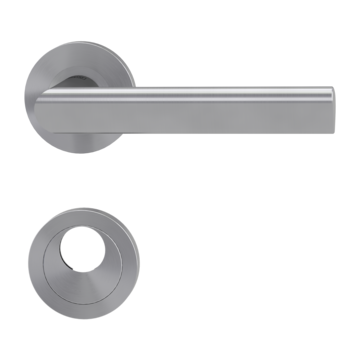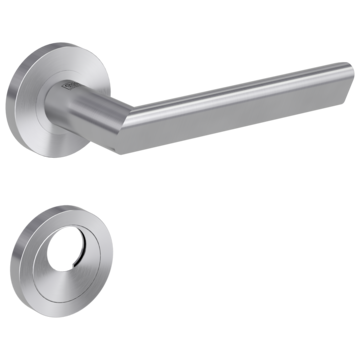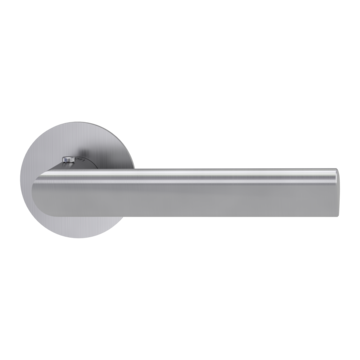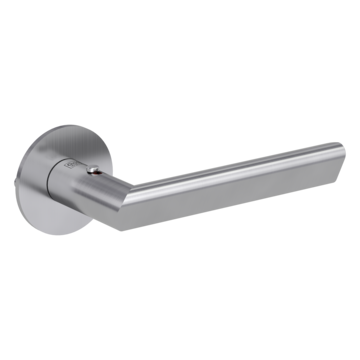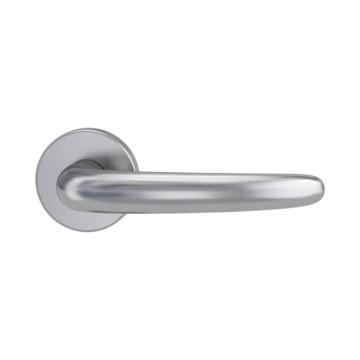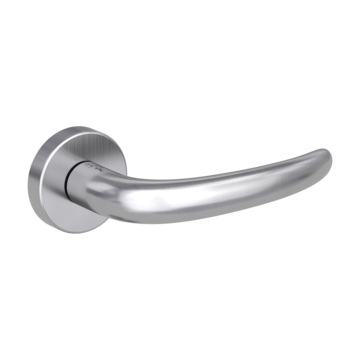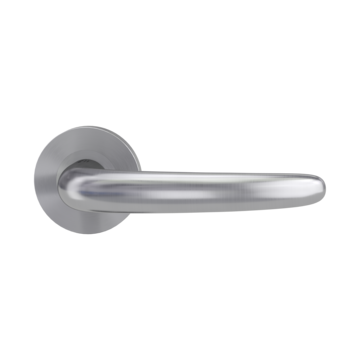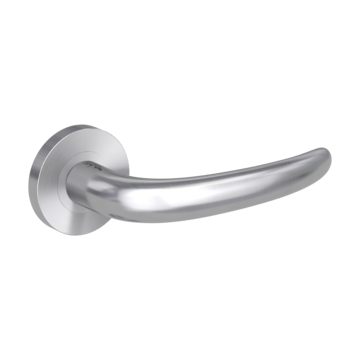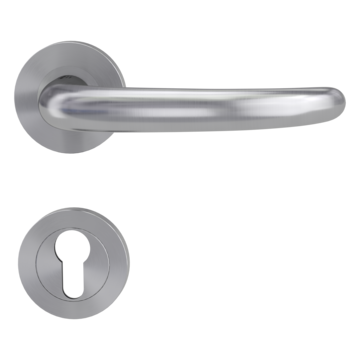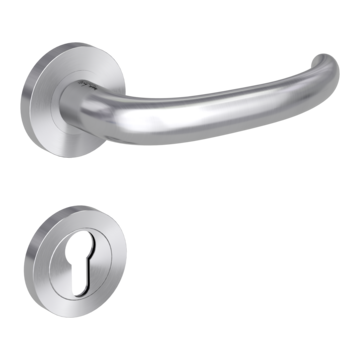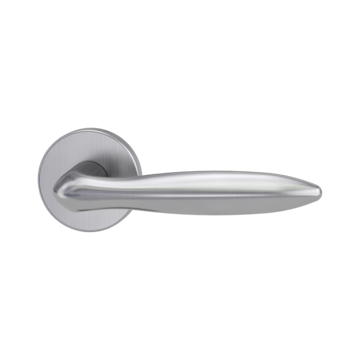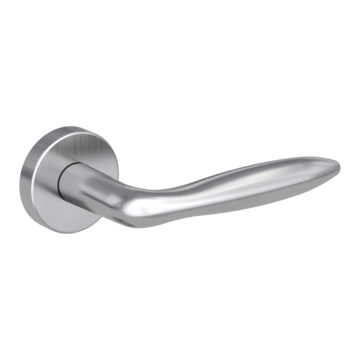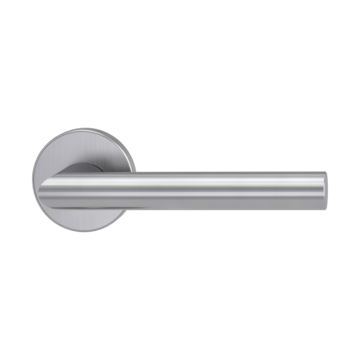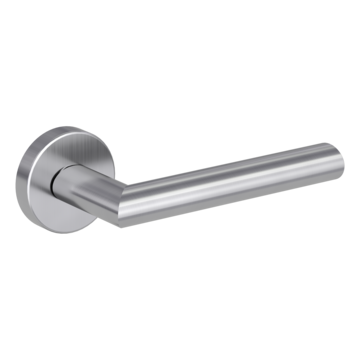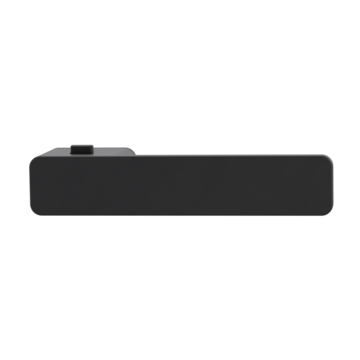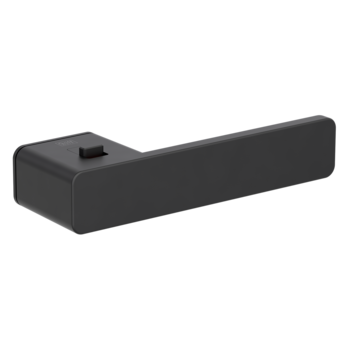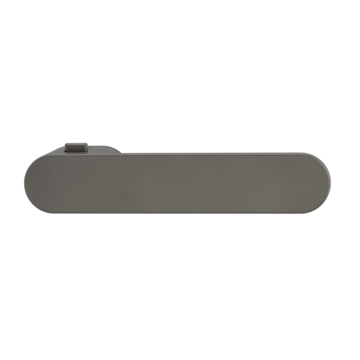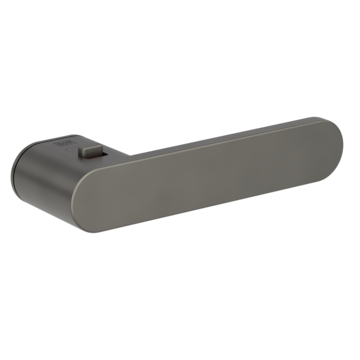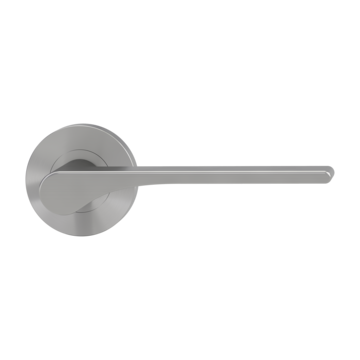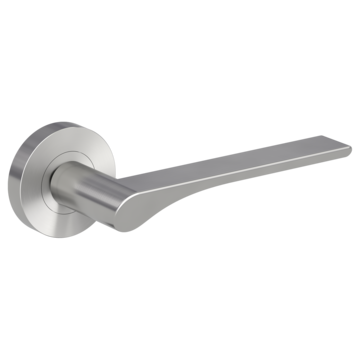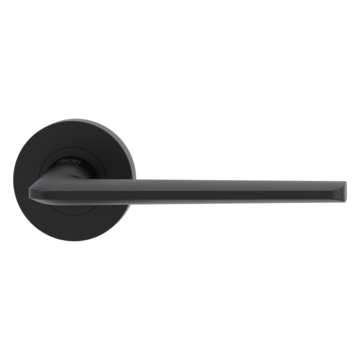All about door hardware
Door fittings make every exterior and interior door moveable: we use them to open and close them. Find out here what materials Door handles are made of, what types of Door handles there are and whether Door handles are actually standardized.
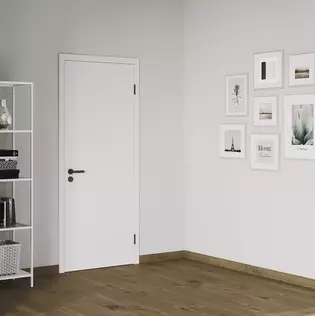
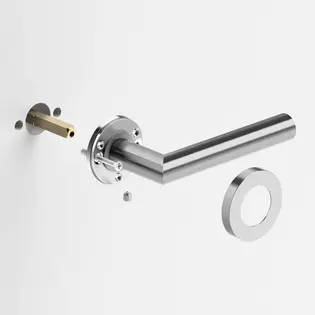
A door basically consists of the door frame (also: frame), which is anchored in the wall and the door leaf, which moves, suspended on hinges, to allow access. The hinges act as pivots on one side of the door leaf. The lock case and Striking plate are located on the opposite side. Lever handle sets - consisting of two door handles, two door plates or door rosettes, which are connected to each other with a lever pin through the door leaf, act as handles.
Selection Griffwerk door fittings
Door hardware materials
Door fittings are mainly made of metals - such as Aluminium, Stainless steel or brass. However, fittings made of plastic are also used. Each material has its own special features:
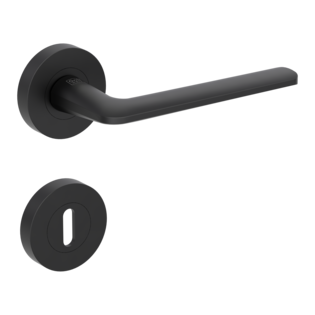
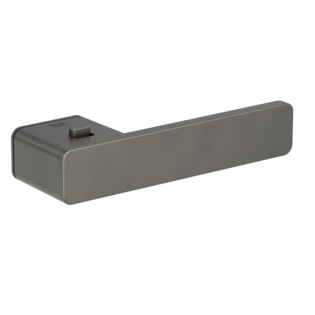
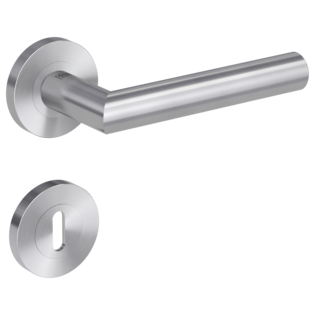
Door fittings made of Aluminium - easy to clean and durable
A door fitting made of Aluminium is mostly made of corrosion-resistant alloys. These have a so-called anodized finish - an invisible protective layer on the Metal. This makes the material more resistant to moisture such as hand perspiration and mechanical impact. Door fittings made of Aluminium are durable, robust and easy to clean. In addition, they are available in many different color variations - whether matt or glossy.
Fittings made of plastic - hygienic and versatile
Door hardware made of plastic can be found both indoors and outdoors. As a rule, they are made of polyamide, which allows a wide variety of colors. The material is particularly easy to clean and maintain, which is why it is often used in facilities such as medical practices or nursing homes. Furthermore, compared to metals, plastic does not become statically charged. Although plastic door hardware is resistant to abrasion, it does have one disadvantage: it is susceptible to NL radiation and thus has a shorter service life, depending on the incidence of light. On the other hand, these door fittings are particularly inexpensive.
Stainless steel door hardware - resistant and robust
Stainless steel door fittings provide an aesthetic and functional addition to any door. Their robustness and resilience make them a popular choice for residential, office and industrial environments. The chrome-nickel steel alloy from which the fittings are made not only ensures high corrosion resistance, but also gives the fittings an attractive appearance. However, in order to preserve the high-quality appearance and functionality of stainless steel door fittings for years to come, a few care instructions must be observed.
Care and maintenance of Stainless steel door fittings
- Regular cleaning: A soft, damp cloth is usually sufficient to remove fingerprints, dust and light soiling. For more thorough cleaning, use special stainless steel cleaners that are tailored to the properties of the material. These cleaners help to preserve the original finish and prevent the ingress of moisture that could cause corrosion.
- Polishing: As mentioned earlier, regular polishing not only increases the shine of your Stainless steel door fittings, but also helps to improve corrosion resistance. For polishing, use a soft, non-abrasive cloth and special polishing agents for Stainless steel. Be sure to polish in the direction of the polishing pattern to avoid scratches.
- Avoiding rust: Although Stainless steel is highly resistant to corrosion, the use of fasteners made of other materials, such as normal steel screws, can lead to the formation of rust, which can spread to the fittings. Therefore, always use Stainless steel screws during installation to ensure uniform corrosion resistance.
- Protection against aggressive substances: Certain cleaning agents, chlorides, acids and even salt water can attack Stainless steel. Avoid contact with such substances and, if necessary, rinse the fittings with clear water to remove any residue.
- Inspection and maintenance: Regularly check the condition of your Door fittings, especially in high traffic or damp environments. Look out for signs of wear or corrosion and take countermeasures at an early stage if necessary.
By following these care instructions, you can significantly extend the service life and appearance of your Stainless steel door fittings while ensuring the functionality and safety of your Doors.
Brass fittings - high quality, but require maintenance
Brass alloy door hardware is more susceptible to corrosion than other metals. Without proper care, they can darken - a patina can form. Therefore, make sure to clean them regularly with special, mild brass cleaners and apply a corrosion protection. If you choose brass only for aesthetic reasons, you'd better choose Stainless steel fittings with a Brass effect.
Finding the right door hardware: this is how it's done
The door hardware should naturally match the door. Which materials of the door leaf, door frame, hardware and door handle create a harmonious picture? Which properties are particularly important to you? What durability and care do you want? It is best to ask your specialist dealer for advice on this. You will find tips on special fittings for Glass doors here.

The great door hardware 101
When we speak colloquially of Door handles in Germany, we actually mean Door handles as the generic term for all handles used to open or close a door.
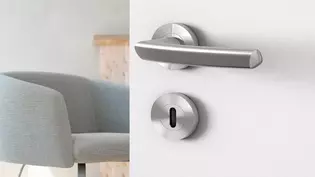
Door fittings - the German Standard
The most widespread in Germany is the Door handle. Everyone knows it: an angled lever that has to be pressed down. Due to a mechanism, the latch in the lock case retracts - the door opens. Door handles are also called Lever handles in Germany. In Austria the term Türschnalle is common, in Switzerland the name Türfalle. Door handles are mainly used for room doors because they are easy to use. If you have None hand free, an elbow can also be used to open the door.
This simplicity is both a curse and a blessing: Even small children or pets quickly learn how to use the Door handles. Therefore, if the door is to remain locked, Door handle sets are usually equipped with a rosette or a door plate with a keyhole, so that the door can be secured against unauthorized access with the help of a key.
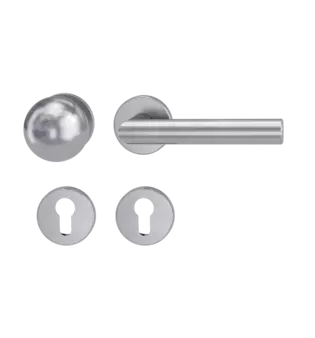
The doorknob - internationally popular
In the USA, the doorknob - also known as the button handle - is found particularly frequently. This is a rotating knob that must be turned, rather than pushed down, to operate the opening mechanism. Since this turning motion must be done by hand, this door handle is somewhat more difficult to operate and safer in households with small children or pets.
In Germany, changeable locks are more commonly used for front doors. These are combinations of handle and knob: Door handle on the inside, door knob on the outside. The door knob is usually fixed and cannot be turned. The door can only be opened from the outside with a suitable key.
The push handle - perfect door hardware for public traffic.
Push handles are rarely found in the home - for example, on double-sided hinged doors. The special feature of push handles is that they do not have an opening mechanism like Door handles or door knobs. Therefore, they can only be installed on doors without a door latch and lock case. The door is simply pushed or pushed open. In this case, a Bar handle is usually mounted as a door handle, which facilitates opening. In churches or museums you can often find decorated Bar handle elements, for example, in the form of animals again.
A special form is the handle shell, which is let into the door leaf. This is mainly used for Sliding doors.
Push handles are less susceptible to wear, since the opening mechanism is omitted. They are used primarily in public buildings such as hospitals or train stations, but also in shopping malls where there is heavy foot traffic - in other words, wherever doors need to be opened quickly and without effort.
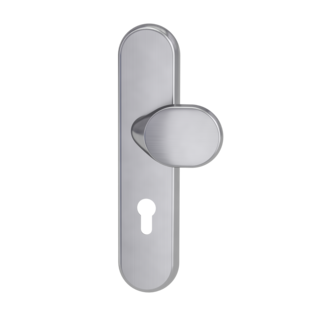
Security door handles - the best door fittings for your security
To keep burglars out, make sure that Security door fittings have an invisible screw fixing to prevent unscrewing from the outside, a hardened steel plate for greater resistance to drilling, and a cylinder cover made of hardened Steel: This way, no one can pull out the Profile cylinder.
The most frequently asked questions about door hardware
What questions are most often asked about door hardware? We found out using software that analyzes the questions people ask voice assistants from Apple, Google and others. We answer four of them here:
Are Door handles actually standardized?
Counter question: Have you ever missed the Door handles? Probably not. In fact, Door handles are standardized, so you can directly find the handle of the door even in the dark, with strangers or in a hotel. The standardized height is 105 cm from the Floor.
However, special sizes, e.g. because of a disability, are also possible. Ask the manufacturer for a special design.
How to find the right door hardware to the door?
Door hardware is selected to match the door and the interior. The most common colors are silver, gold or Black. Plastic door hardware usually has a wider range of colors.
What are the different types of door hardware?
There are several types of door hardware including: Locks Handles Handles Latches Latches and lock cylinders. Each type has its own specific characteristics and functions.
What material should be used for the door hardware?
The most common materials used for door hardware are Steel, Stainless steel, Brass and Chrome. Brass and steel are the most common materials for locks and handles while Chrome and Stainless steel are popular choices for design elements such as latches and handles.
There are several materials to choose from depending on various factors such as aesthetics, function, durability and budget. Here are some common materials used for door hardware:
Stainless steel: Stainless steel is another popular material for door hardware. This Steel is very durable and resistant to corrosion and rust. In the Griffwerk range.
Zinc: Zinc is an inexpensive and durable material that is often used for door hardware. It can be produced in many different colors and finishes. In the Griffwerk assortment for zinc die-cast forms (Zamak)
Aluminum: Aluminum is a lightweight Metal that is often used for very low cost door hardware. (Currently not in the Griffwerk assortment)
Brass: Brass is a classic material for door hardware and offers a timeless look for certain . It is also very durable and corrosion resistant. (Currently not in the Griffwerk assortment, but brass look by a high quality coating on various Zinc fittings)
Ceramic: Ceramic is a traditional material for door hardware and offers a unique and eye-catching look. However, it is not very brittle and can break easily. (Currently not in the Griffwerk assortment)
Plastic: Plastic is an inexpensive and lightweight material that can be used for door hardware. It is available in a variety of Colors and Designs, but it is not as durable as other materials and can be easily damaged. It may also not be as corrosion resistant as other materials and may discolor or yellow over time.
Ultimately, the material you choose for door hardware depends on your personal preferences, your budget, and the specific requirements you have for your door hardware. It is also important to consider the quality of the material and the manufacturer to ensure that the door hardware is durable and reliable.
Why is it important to choose the right door hardware?
Choosing the right door hardware is important to ensure the security and functionality of the door. A secure lock case can deter burglars while a simple handle or latch can make the door easier to operate. It is also important to choose door hardware that matches the design and style of the building.
